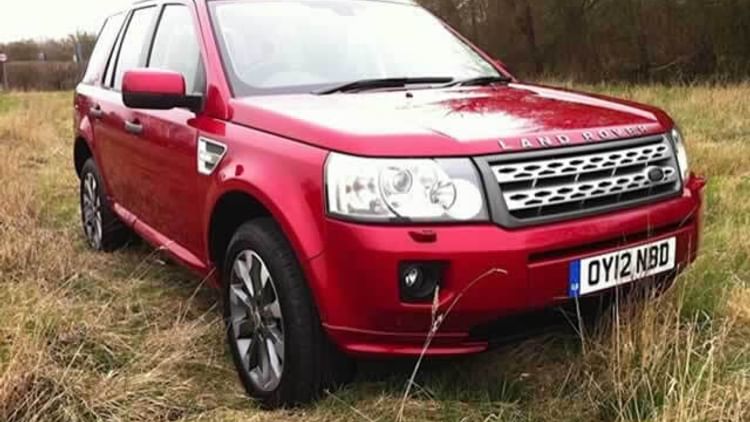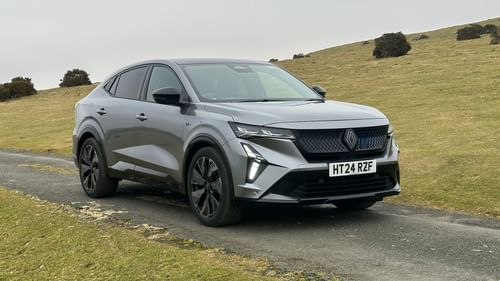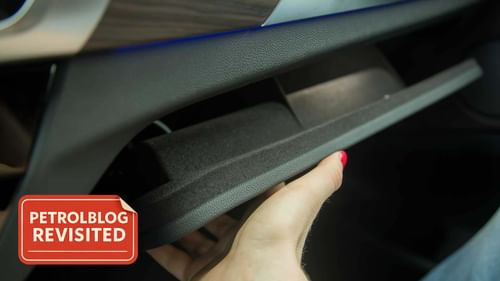
PetrolBlog is usually your chosen repository for automotive waffle and bunk so we were slightly surprised to receive an invitation from the nice people at Jaguar Land Rover to experience its range.
Never ones to turn down the opportunity to try something new we sent Rob Griggs-Taylor to the National Motor Heritage Centre at Gaydon on a slightly overcast day, where a mouth-watering range of cars were lined up for his convenience. Makes a change from Skoda Favorits and Shatchbacks, eh?

Jaguar Land Rover has come through some rough times and, in recent years, has introduced vehicles that are held in high esteem. The Jaguar XF, now available with a 2.2 litre diesel engine, and the Land Rover Evoque with two wheel drive were highlighted as models we might like to try by the PR team at JLR.

So in true PetrolBlog style, we decided to ignore those and drive three of the overlooked cars from their range. First up; the Land Rover Discovery TDV6.
It's hard to believe that it was 1989 when Land Rover introduced the original Discovery model. At the time it was a revolutionary addition to a range which included only two models, the Defender and Range Rover. The Discovery was, for some years, arguably the most discussed model in the line up as it was different and new. However, by the introduction of the 4 it has somewhat faded into the background, with the Range Rover Sport and Evoque seemingly at the forefront of the media and customers' minds.
The fact that Land Rover had only one Discovery available on the day compared to seven Evoques would suggest that even they have it set to one side.
As you approach the vehicle you realise that it's big; very big. Climb up into the driving seat and close the heavy door with a nice 'thunk' you realise that it feels quite cramped, almost like an inverse Tardis. Given that you would have paid around £56,000 (including £5,000 of options) for this car it would be nice to feel that it was a bit more spacious.

Interior fittings were nice - leather upholstery, twin glass sunroofs let additional light in and it is very well equipped.
The key didn't need to come out of my pocket to start the six-cylinder turbo diesel engine, which sounded nice and grumbly. Initially you are very aware of the size and weight of the Discovery so you tend to be a bit cautious but after a bit of familiarity you start to push a bit harder.
Putting out over 250BHP you expect a bit of go, but this car weighs a lot which slightly blunts acceleration. Don't go thinking that it's slow though - it'll happily get to 60mph in around 8.8 seconds and sit at 70mph (or more) on the motorway. It also copes admirably on sweeping A-roads, easily keeping up with seemingly more agile cars. You can really hustle this thing along, and it's only the natural caution which comes with the weight, size and the sensation that you just might end up on the door handles that limits cornering.
One benefit of the size of the Discovery 4 is the commanding driving position. You can see the edges of the bonnet allowing you to place the nose of the car with precision, and the ability to see oncoming traffic over hedges and walls helps when planning an overtake. A colour screen in the dashboard displays the rear view when you select reverse, which helps a great deal when backing the Discovery into tight spaces.

Now fitted with an 8-speed automatic gearbox the official fuel consumption figures stretch to nearly 35mpg for the extra-urban cycle. In my mixed driving route I managed only 21.8mpg on the trip computer but that's fairly respectable for such a mammoth beast.
I was initially surprised to find a 'sport' mode on the gearbox which combined with paddles on the steering wheel to allow the driver control. However it was most useful when trying to make a fast exit from a junction as the fully automatic mode seemed to have some difficulty in determining what the driver required. It truly felt like the delay between pressing the accelerator pedal and the gearbox/engine combo feeding the power to the wheels was a result of some tiny Land Rover goons shouting "Bridge to Engine Room - FULL AHEAD BOTH!" through some kind of Discovery 4 internal intercom system.
Finally, the one thing that made me wonder if I could live with this car was the bouncy suspension. On some rutted and bumpy lanes I found myself clinging to the steering wheel as the big Disco bounded from bump to bump, wondering how my wife and kids would be feeling and coming to the conclusion that sick might be involved.
That one minor negative aside, it's entirely possible that the Land Rover Discovery 4 TD V6 HSE (to give it its full name) could be the best all round vehicle in the JLR range.
Next I moved on to the Land Rover Freelander 2 in now unfashionable TD4 guise with four wheel drive.
One of the things that Land Rover seem to have concentrated on in recent years is the detail stuff, particularly where the owner comes into frequent contact with the vehicle. This was evident when I was handed the key to the Freelander; it was a button encrusted fob with a chunky plastic Tonka-toy feel to it where the Discovery one was clearly of a higher grade plastic with a nice metal edge to it.

Stepping into the Freelander (which externally doesn't look much smaller than its big brother) you find more of the same black plastic, which is slightly incongruous against the beautiful leather trimmed seats.
This time the key fob has to be pushed into a slot on the dashboard before the diesel engine can be fired up. My test car was automatic, which made it quite relaxed to punt around in, but acceleration was accompanied by a Ford Transit-esque noise from the engine. Despite the press pack excluding the 0-60mph time the Freelander was noticeably less brisk than the Discovery.
That needs to be balanced out against a combined fuel consumption figure of a whisker over 40mpg which is pretty decent for a car of this type. On my run the trip computer said I'd achieved only 25mpg but bear In mind that I worked the car fairly hard.

One of the great things about the Freelander was the ride. You can happily ignore potholes, ruts and all the other cracks and ripples in the road surface as the little Land Rover despatches them all with ease. It's a great feeling which gives an unusual sense of freedom as you don't have to spend your time observing the surface and can instead take advantage of the elevated driving position to enjoy the scenery.
At the time of testing the Freelander I have to admit to coming away with a sense of disappointment as it didn't seem particularly exceptional in any way, but it was a decent car which, having seen some of the angles it achieved on the off-road course, is likely to be able to get you almost anywhere in the UK whether or not a road is present.
The bad taste in the mouth was the £36,250 price, to which the car I drove added £1,200 of options. That's a lot of cash, especially compared to the much newer Evoque. It did make me wonder what Land Rover has planned for a presumably forthcoming Freelander 3.
So finally I tried something completely different. Step this way into the Jaguar XK Coupé.
I live near one of Jaguar's UK bases and so I see quite a few of their models on a regular basis and I genuinely can't remember the last time I spotted an XK that wasn't a convertible, an R model or both. The normally aspirated 5.0 litre V8 coupé seems to be the overlooked version and yet, after driving it, I'm not entirely sure why.
The exterior of this car is gorgeous. I adore the shape, especially the profile. I even liked it in the Crystal Blue colour of the test car, a pale ice blue shade that I don't usually rate. And the lovely 5-spoke 20" Takoba wheels set the look off beautifully. It's an elegant coupé with no fussy addenda unlike its cousin, the XKR-S.

Opening the frameless door you get your first glimpse of the cream leather seats and the contrasting blue dashboard. Settle down into the comfortable seat and take in the view. Glance in the door mirror and you can't help noticing the hips of the car in your rear view. Move your fingers to the drivers door where, slightly unnaturally, you find the controls for adjusting the seat position. The seat moves smoothly, powered by electric motors until you arrive at your desired posture.
As with the Discovery 4 the key can safely remain in your pocket. Press the brake pedal and depress the Start button with your left thumb. As the V8 petrol engine starts up with just a blip of revs so you can hear the roar, the circular gearbox selector rises from its initially flush position in the centre console.
Twist the knob three clicks clockwise from Park to Drive, push down on the electric handbrake button just behind it and gently ease the accelerator down. The coupé moves forward. Turn the steering, noting how light it feels. You suddenly realise how nice the stitching feels on the leather steering wheel. It's smooth and feels silky, exactly like the steering. Glance at the instruments and you see traditional looking Jaguar dials, like something from the 1960s perhaps.

This is a smooth car, the engine providing a gentle roar to politely inform you that internal combustion is taking place. Ease out of the car park and turn left onto the main road. Press the accelerator pedal a touch harder and watch the instrument needles move quickly clockwise, with the rev counter needle dropping every so often as the six-speed auto selects the next gear with a completely slurred shift. No jerks, no jarring, just effortless progress.
The steering weights up as the speed rises. Enter the next roundabout on the brakes as you were travelling faster than you thought, and the XK goes exactly where you point it.
A little further down the road you spot a narrow road to your right. Click the solid-feeling indicator stalk up to signal your intention and turn off, suddenly leaving all the traffic and hassle behind. On this spindly bumpy country B-road the Jaguar seems to flatten the bumps leaving your heartbeat on low, adrenaline switched to idle.
Turn on the optional DAB radio and the cabin fills with the sound of a Rachmaninov piano concerto through five hundred and twenty watts of Bowers & Wilkins hifi. You're listening to Radio 3 and it feels appropriate.
As you and the XK meander onwards you pass through a hamlet of wooden-beamed houses, complete with communal red telephone box. Glance down at the speedometer and you find you're proceeding at exactly 29mph. This Jaguar is a pussy cat.
Then you arrive at a T-junction onto a major road. You see the gap in the traffic coming, twist the gear knob one more position clockwise into Sport and thump the throttle. With a slight wheelspin on the loose gravel at the junction the Jaguar pounces forward. Gently pull the right paddle shift and second gear is selected. Keep accelerating and you'll see 60mph arrive in a whisker over five seconds. A quick dab further on the accelerator sees you easily despatch the car in front, leaving you an unrestricted view of the twists in the road ahead.
Turn-in on the bends is precise, acceleration easy to mete out as appropriate for (very) brisk progress. Adrenaline still on low, your brain easily able to cope with all that's taking place. The V8 growl is slightly edgier as you're pressing on, but it's a very polite growl. No anger here.
As you come nearer to your destination, you realise that you rather wish that Jaguar had asked you to deliver this car to Wales. Or Dartmoor. Or Rome.
The Jaguar XK Coupè was my favourite of the three cars tested here. It's the only one I switched the radio on in, the only one in which I set the cruise control. It was equally the one I drove fastest in and the one I posted a photo of on my Facebook page. If I had the £71,000 that this car costs just lying in the bank waiting to be spent, there's a very real possibility that I would have taken this one home. It's predecessor, the Jaguar XK8, has dropped below £5,000 as a used car in normally aspirated four litre V8 guise. Now that might just be the bargain of the decade if you're looking for a genuine GT to cross Europe in. I think you should buy one.

PetrolBlog would like to thank the PR Team at Jaguar Land Rover for the opportunity to drive these cars (and others!). Special thanks to them for the sense of humour that was prevalent, even in the signposting.





